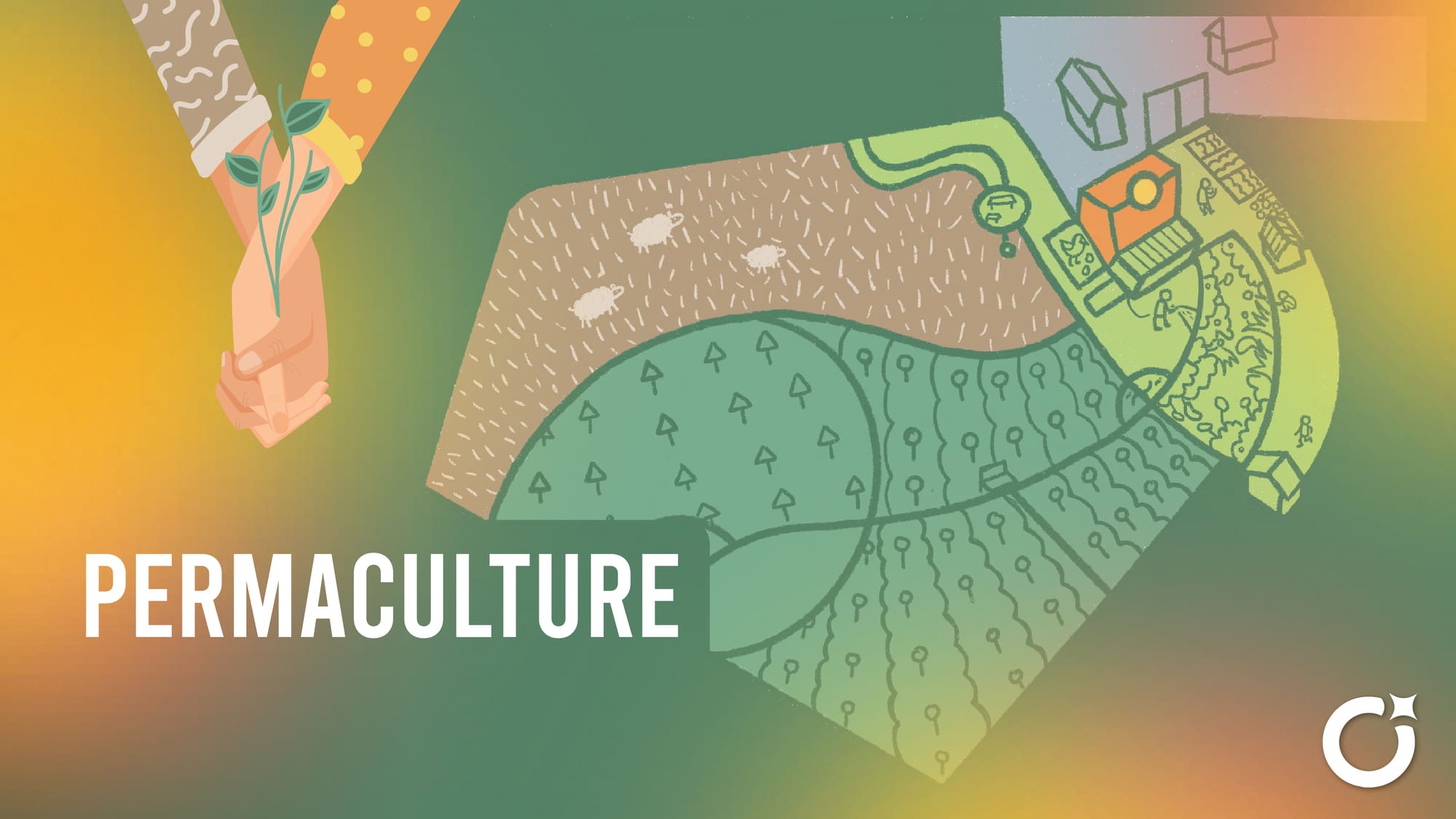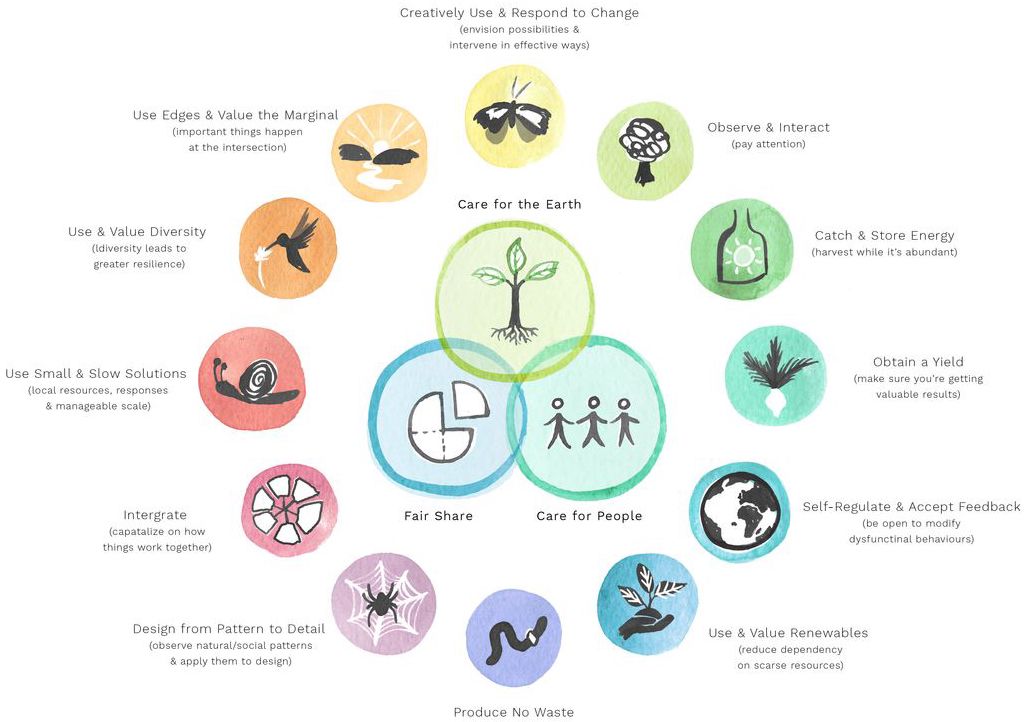
Illustrated by Himanshi Parmar
“Not everyone has access to land, but everyone has access to culture.”
Pedro, our lead facilitator and guardian of the land at Terra Alta, said this line that significantly impacted me during my Permaculture Design Course in September 2022. It made me realize that one need not have a piece of land outside the city to live a life that was purposeful and full of care. One could integrate permaculture into every life and interaction.
This piece attempts to grasp and briefly share the vast knowledge of permaculture post doing a Permaculture Design Course, hoping to inspire more to explore and experiment with this path.
Permaculture is not only about land or how to grow vegetables; it is a mindset, a culture, a way of life and being, that can influence and inform everything. From how you interact with your family and colleagues to growing your vegetables; from dealing with the socio-politics of the refugee crisis to how we tackle climate change; on a micro and macro level, permaculture principles can be applied anywhere, everywhere.
So, what is permaculture exactly?
Permaculture is a set of 12 principles guided by three ethics - earth care, people care, and fair share.
Permaculture is short for 'permanent culture/agriculture,' thinking and practices that inspire regeneration (at its very best) rather than depletion, as it guides us to learn from (and apply) patterns and relationships from nature.
These principles can assist us in designing and organize not just our land but also our personal,economic, social, and political systems.
Permaculture aims to create ecologically sound, economically viable, and self-sustaining systems. It is a guideline for turning problems into actionable, constructive solutions. Permaculture asks you to look within, starting from the self at home, then spiral out to a broader community, always with the benefit of the environment.

It is indeed hard to define permaculture because it is not static but dynamic. It is a lens throughwhich one views and interacts with the world. Due to its dynamism, the "symptoms" ofpermaculture can be incredibly different from person to person, project to project. It is apersonal relationship, but at its core, it asks us to listen to, learn from and work in tandem withnature (humans included).
One of our exercises towards the end of the course was to write out what permaculture meant to each person. I wrote, "permaculture is a thinking that is collaborative with all vibrating entities governed by respect and purpose." I have shared some answers from my fellow coursemates below to give you a sense of how varied and wonderful the response could be after 14 days in a cork forest valley in Portugal learning about permaculture.
“Permaculture is a quality of experience entangled with the web of life that gently and with a singing voice, embraces me to ride the wave of synchronicity”
“Permaculture is unity.”
"Permaculture, to me, is listening, and actively responding to the needs of nature around us, in the soil, in local community, and within us"
What is a Permaculture Design Course?
Bill Mollison, arguably the father of permaculture, consolidated the Permaculture Design Course (or PDC), to impart the necessary skills required to apply to land or life. A PDC can be an entry point to permaculture.
As permaculture teaches us, everything depends on our context- what we start with and want to achieve. Hence, each PDC is different. Each focuses on various aspects of the knowledge of permaculture and its practice. Some enthusiasts do multiple PDCs to learn and study the same culture from many different angles and perspectives; some may go on to research permaculture further through a diploma course or spend more time studying through experience.
While each course will cover the 72-hour curriculum designed by Bill Mollison, they may focus on different aspects through different learning styles. The 72-hour curriculum covers an introduction to permaculture, ethics, principles, designing strategies and tools like zoning or sector analysis, observation, and application of patterns and soil health, to name a few subjects.
While Bill Mollison, David Holmgren, and some of the earlier permaculture thinkers focused on applying permaculture to the land, Looby McNamara and her book 'People & Permaculture' widened the perception of permaculture and accelerated the applications of these principles, ethics, and values to people and all aspects of life.
This illustration exemplifies this interrelation between the land and people, using one of thecritical aspects of permaculture design- zoning. Zoning is a tool used to identify and mark landor your social structure based on the frequency of interaction. It helps understand your physicaland social space and design the most effective and efficient systems and relationships. Itreflects the need for segregation in understanding integration and interactivity.
Experiencing a Permaculture Design Course
I did my PDC at Terra Alta, a beautiful piece of land in a valley on the west coast of Portugal. I had my eye on this place for some time, and I chose it purely because it came into my radar through a range of lovely synchronicities. That is how I often make decisions, but more tangible aspects may inform others. When choosing your course, go for what feels suitable for you.
It was a two-week residential course where we camped in a beautiful cork oak forest, danced, cooked, learned, laughed, gardened, and grew together.
The course was structured into ‘lectures’ and ‘hands-on sessions’.
The lectures covered subjects like ethics, values, social permaculture, soil health, kitchen gardening and planning, herbalism, and biodynamic farming, amongst other subjects. The classrooms were fun, playful, and interactive. The board games and role-playing in imaginary town hall meetings made the learning accessible for the knowledge to seep in for many of us that had spent years outside a classroom environment.
During the ‘hands-on session’, we practiced some of the teachings and tactically learned different skill sets. I appreciated Pedro's vision to quell any romantic ideas city folk (me included) may have about living off-grid on a piece of land in harmony with nature. It is challenging work, and some of these hands-on sessions were an insight into the effort it takes to uphold the ways of permaculture. The sessions included gardening, forestry, fermentation, cooking, mushroom propagation, natural building, zone building, and defining to name a few.
My biggest takeaway from this course is that permaculture can be applied anywhere. ‘Observe and interact’ and take action accordingly to adjust our lives through permaculture. Understanding and tweaking my own city life to these principles is very fulfilling.
Others in my course have gone on to apply the principles in their new start-ups or helped to transform old, almost arid land in a traditional farming community in India. Some have started to ferment more food and pay attention to the seasons more, while another is working with sustainable companies and guiding their marketing policies through permaculture principles.
Why anyone comes to learn about permaculture and what one does with it varies, but it is vital to hold the holy trinity in the center of our being and let it spiral through our lives. Earth care, people care, fair share.